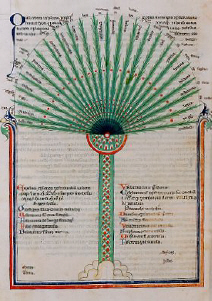But then Heidegger makes a rather remarkable claim. He says that for Aristotle this noetic activity that secures the truth of being is fulfilled principally in two ways of revealing: sophia and phronesis (PIA1 255). It seems to me to be important that Heidegger does not see Aristotle as tying phronesis to sophia in a hierarchical way, such that sophia would be the disclosure of the arche while phronesis would be the equivalent of an apophantic disclosure of the synthesis of the true and the false. Both sophia and phronesis are noetic activities, ways of carrying out and fulfilling our primordial relationship to what is. What then is the difference between sophia and phronesis?
Heidegger translates phronesis as Umsicht (circumspection). He also, at least implicitly, offers Sorge (care) as another translation. In this text, Sorge has mostly to do with one’s dealings in everyday factical life, what Heidegger calls Sorgensumsicht. Phronesis, Heidegger says, is only possible because it is primarily an aisthesis, an ultimately simple view of the moment (the kairos). It is in praxis that this phronetic moment of factical life is revealed in its fullness and brought to fruition. But this practical situating of oneself out of an overview of one’s being is for Aristotle a noetic activity, a nous praktikos.
What specifically concerns Heidegger here is the movement of this practical disclosure wherein the fullness of the moment of being can draw back into itself its past and future. Phronesis is here understood as a way of having one’s being, a hexis. Just as the earlier analysis of death belonged to the broader context of the question of factical life, so here also Heidegger has not so clearly worked out the primacy of the future and of possibility as he later formulated it in Being and Time. In this regard, his analysis here of Aristotle’s project is still close to Husserl and Husserl’s concept of phenomenology. But, as Heidegger shows, this way of having its being that belongs to human factical life is peculiar. There can be no pure, atemporal beholding of such being since the moment of praxis is always already caught up in the coming to be of factical life. Therefore, phronesis, though a kind of revealing and a noetic activity, is always a doubling regard (“eine Doppelung der Hinsicht”) (PIA 255). Human life is situated in this double regard of phronesis as a way of revealing and seeing being.
In contrast, Heidegger’s treatment of that other noetic activity, sophia, is ambiguous. He clearly attempts to show that sophia has to do (219) with divine movement, not with the movement of living being. The mistake that has pervaded the tradition, namely, interpreting all being on the basis of what is revealed in sophia, has its roots in a certain theological bias, as Heidegger explained in an earlier part of this text. But it also can be traced to a certain ambiguity on the part of Aristotle. To a certain extent, Aristotle’s concern about divine being causes him to define living being in terms of what it is not, that is, in terms of its not being necessary and eternal. This blocks, to some extent, a more original and positive access to the peculiar kind of movement and being that is involved. But, more importantly, Heidegger also finds that the dominant concern with the movement of production—with techne and poiesis—and the use of produced beings as exemplary beings in Greek ontology has its roots in this same failure to properly distinguish sophia and phronesis. For sophia is also the appropriate basis for the way of revealing that is involved in production. In other words, techne is governed by a kind of understanding of sophia. When beings from techne, produced beings, become the exemplary beings for the analysis of living being, then this double movement we discussed earlier, the movement of being whose arche belongs to its being and does not come from outside, gets separated out into two separate regions of being and beings.
“Phänomenologische Interpretationen zu Aristoteles (Anzeige der hermeneutischen Situation),” ↩
